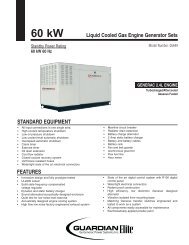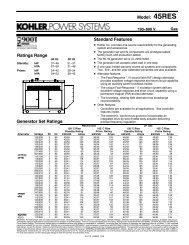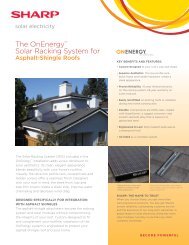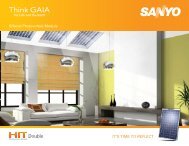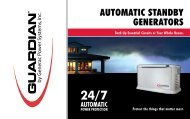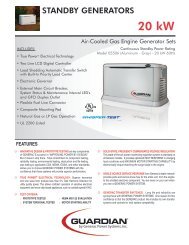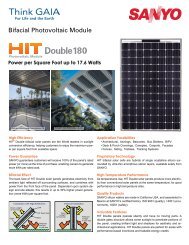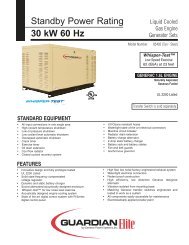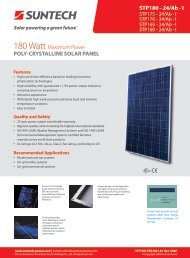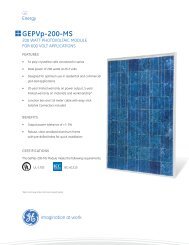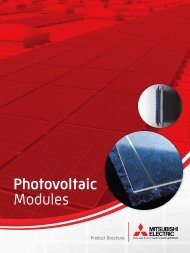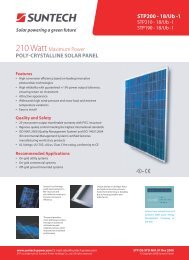ES-B Series Photovoltaic Panels - Evergreen Solar
ES-B Series Photovoltaic Panels - Evergreen Solar
ES-B Series Photovoltaic Panels - Evergreen Solar
Erfolgreiche ePaper selbst erstellen
Machen Sie aus Ihren PDF Publikationen ein blätterbares Flipbook mit unserer einzigartigen Google optimierten e-Paper Software.
- Safety Class 2 protection is assured as long as all the components or housings used to accomplish<br />
grounding are Safety Class 2 certified.<br />
- <strong>Evergreen</strong> <strong>Solar</strong> recommends that the grounding kits or solutions supplied by many inverter<br />
manufacturers are used to electrically ground systems with <strong>Evergreen</strong> <strong>Solar</strong> panels.<br />
- Transformer-less inverters cannot be negatively grounded, so <strong>Evergreen</strong> <strong>Solar</strong> requires that only<br />
inverters are used which can be negatively grounded or which do not expose the panel strings to a<br />
negative voltage relative to ground.<br />
- A few types of transformer-less inverters do not expose any part of the panel strings to a negative<br />
voltage relative to earth. In these cases, and only in these cases, panels of model type “fb1” may be<br />
used without grounding the negative DC pole.<br />
- According to IEC 60364, section 712.312.2 the grounding of active wiring on the DC side of an array<br />
is permitted as long as there is electrical separation between the AC and DC sides of the inverter.<br />
Inverters with a transformer have galvanic separation between the AC and DC sides, so their operation<br />
in electrically grounded PV arrays is completely compatible with IEC standards.<br />
- Transformer-less inverters do not have galvanic separation between the AC and DC sides and therefore<br />
do not meet IEC standards if electrically grounded.<br />
Mechanical Installation<br />
• <strong>Panels</strong> should be mounted to maximize direct exposure to sunlight and to eliminate or<br />
minimize shadowing.<br />
• Even partial shadowing can substantially reduce panel and system output.<br />
• <strong>Panels</strong> must be securely fastened using support frames or mounting kits specialized for<br />
PV applications.<br />
• <strong>Panels</strong> may be mounted at any angle from vertical to horizontal orientation.<br />
• Care must be taken to avoid low tilt angles which may cause dirt to build-up on the glass against the<br />
frame edge.<br />
• Dirt build-up on the surface of the panel can cause active solar cells to be shaded and electrical<br />
performance to be impaired.<br />
• Contact <strong>Evergreen</strong> <strong>Solar</strong> for more information regarding minimum recommended tilt angles for<br />
specific panel products.<br />
• For roof mounted systems, provide adequate rear ventilation under a panel for cooling (100mm: 4 in.<br />
gap minimum).<br />
• Clearance of 7mm:¼ in or more between panels is required to allow for thermal expansion of<br />
the frames.<br />
• Always keep the back surface of the panel free from any foreign objects or structural elements which<br />
could come into contact with the panel, especially when the panel is under mechanical load.<br />
• Ensure panels are not subjected to wind or snow loads in excess of the maximum permissible loads and<br />
are not subjected to excessive forces due to thermal expansion of the support structure.<br />
• <strong>Evergreen</strong> <strong>Solar</strong> permits several different mounting methods. The permissible mounting methods<br />
and maximum permissible wind and snow loads are detailed in the Mounting Guide available from<br />
<strong>Evergreen</strong> <strong>Solar</strong> (IEC 61730 compliant version).<br />
• For permission to use mounting methods not described in the Mounting Guide (IEC 61730<br />
compliant version), please consult <strong>Evergreen</strong> <strong>Solar</strong>. Failure to do so will void the warranty and<br />
panel certification.<br />
• Always follow the mounting equipment vendors’ installation instructions in addition to the instructions<br />
found in the Mounting Guide (IEC 61730 compliant version). In cases where the vendors’ instructions are<br />
more stringent than those detailed in the Mounting Guide (IEC 61730 compliant version), the vendors’<br />
instructions shall apply.<br />
• In cases where the maximum permissible loading determined by the mounting equipment vendor is<br />
less than the maximum permissible load stated in the Mounting Guide (IEC 61730 compliant version),<br />
the maximum loads determined by the vendor should always be used.<br />
• The maximum permissible loads apply to uniformly distributed wind or snow loading. Care should be<br />
taken to avoid mounting panels in areas that are prone to drifting snow, icicle and/or ice dam formation.<br />
Valid from 1st November 2008 / IMW-<strong>ES</strong>-B_EN_DE_011108_IEC<br />
4



